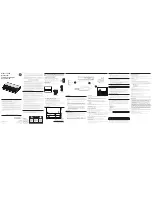
Fabric OS 5.2.x administrator guide 401
have a McDATA switch between two HP StorageWorks switches if you are managing zoning from the
HP StorageWorks switches.
•
LC IBM GBICs are not supported if they are connected to a McData ISL.
•
When a switch gets a new domain ID assigned through a fabric reconfiguration, the new domain ID is
written to nonvolatile memory and the old domain ID value is overwritten. When a McDATA switch gets
a new domain ID assigned through a fabric reconfiguration, it keeps the original domain ID in
nonvolatile memory.
IMPORTANT:
In this scenario, when the domain ID of both a McDATA switch and an HP
StorageWorks switch are changed via fabric reconfiguration, on the next and subsequent fabric
reconfiguration(s), the latter switch attempts to use the new ID (from the nonvolatile memory) while
McDATA attempts to use its old ID (from the nonvolatile memory). This situation might cause a
domain ID overlap to occur during multiple fabric reconfigurations. Domain ID overlap is not
supported for HP/McDATA interoperability.
•
Between HP StorageWorks switches, you can connect more than one ISL when in interoperability mode.
Zoning restrictions
The following restrictions apply to zoning in interoperable fabrics:
•
When interoperability mode is in effect, the space available for the zoning database is about half the
usual size. The maximum zoning database size in interoperability mode is 1:1.8 of the native mode
zoning database size
•
Only zoning by port WWN is allowed; you must use the port WWN of the device, such as
10:00:00:00:c9:28:c7:c6.
•
Zone members specified by node WWN are ignored.
•
Zone configurations that use either physical port numbers or port IDs are not supported in
interoperability mode. Zoning using port numbers uses the actual physical port numbers on the switch;
for example slot 1, port 5.
•
When a zoning configuration is not in effect, by default all ports are isolated and traffic is not
permitted. This is unlike HP StorageWorks switch behavior where
Interoperability
mode is off (and all
data traffic is enabled). If using default zoning, no device can communicate with any other device in
the fabric if zoning has been disabled on an HP StorageWorks switch. Refer to the section ”
Activating
Default Zones
” on page 261“.
•
HP StorageWorks 4/16 and 4/8 SAN Switch, SAN Switch 2/8EL, SAN Switch 2/8V, SAN Switch
2/16, SAN Switch 2/16V, SAN Switch 2/32, SAN Switch 4/32, Core Switch 2/64, SAN Director
2/128, and 4/256 SAN Director models provide hardware enforcement of the port WWN zones only
for devices attached to their ports. Devices attached to end-ports on non-HP switches or 1 GB switches
are enforced by Name Server (soft) zoning only.
•
Web Tools can be used for zone configuration as long as HP StorageWorks switches are connected
directly to each other. If Web Tools is used to set up zoning, then it must be used as the only zone
management method.
•
HP StorageWorks switches connected to a McDATA switch receive the effective configuration when a
zone merge occurs. (McDATA only has an effective zone configuration and discards the defined zone
configuration when it sends merge information to the HP StorageWorks switch.) However, a zone
update sends both the defined and the effective configuration to all switches.
•
When a switch or Director is reconfiguring, wait until the fabric routes are completely set up before
entering zoning commands that must propagate to other switches. Use the
fabricShow
command to
verify that all fabric routes are set up and all switch IP addresses and names are present. (The
fabricShow
command only shows the WWN and domain ID for switches from other manufacturers.)
•
The maximum number of items that can be stored in the zoning configuration database depends on the
switches in the fabric, whether or not interoperability mode is enabled, and the number of bytes
required for each item.
Summary of Contents for AE370A - Brocade 4Gb SAN Switch 4/12
Page 18: ...18 ...
Page 82: ...82 Managing user accounts ...
Page 102: ...102 Configuring standard security features ...
Page 126: ...126 Maintaining configurations ...
Page 198: ...198 Routing traffic ...
Page 238: ...238 Using the FC FC routing service ...
Page 260: ...260 Administering FICON fabrics ...
Page 280: ...280 Working with diagnostic features ...
Page 332: ...332 Administering Extended Fabrics ...
Page 414: ...398 Configuring the PID format ...
Page 420: ...404 Configuring interoperability mode ...
Page 426: ...410 Understanding legacy password behaviour ...
Page 442: ...426 ...
Page 444: ......
Page 447: ......
















































